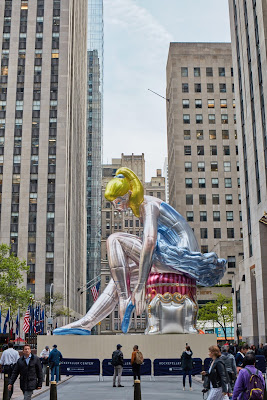 |
| Seated Ballerina, 2017 © Jeff Koons / Photo: Tom Powel Imaging |
Kiehl's Since 1851 and Art Production Fund are pleased to present Jeff Koons's Seated Ballerina, a large-scale public art installation, hosted by Tishman Speyer at Rockefeller Center from May 12 – June 2, 2017. The inflatable nylon sculpture stands 45 feet high and depicts a seated ballerina from the artist's iconic Antiquity series.
Often referencing historical imagery and found objects, Koons based Seated Ballerina on a small porcelain figurine. The sculpture acts as a contemporary iteration of the goddess Venus, and symbolizes notions of beauty and connectivity. Its reflective surface mirrors its immediate environment and engages with each viewer. The work aims to bring awareness to National Missing Children's Month this May, in an effort to support organizations like the International Centre for Missing & Exploited Children (ICMEC) that work tirelessly to create a safer world for children.
"It's a pleasure to work with Kiehl's and Art Production Fund on this charitable project. This partnership will increase awareness and help the International Centre for Missing & Exploited Children make the world a safer place for children," said Jeff Koons. "I hope the installation of Seated Ballerina at Rockefeller Center offers a sense of affirmation and excitement to the viewer to reach their potential. The aspect of reflectivity emulates life's energy; it's about contemplation and what it means to be a human being. It's a very hopeful piece."
"We have enjoyed a great relationship with Jeff Koons, starting with Puppy and recently with Split-Rocker, which were both a tremendous success," said Tishman Speyer President and CEO Rob Speyer. "It's an honor to work with the Art Production Fund and Kiehl's and bring Jeff's art back to Rockefeller Center. Seated Ballerina promises to offer one of those unforgettable New York experiences that will be remembered for years to come."
"We are honored to work with Jeff Koons, Kiehl's and Tishman Speyer to present Seated Ballerina at Rockefeller Center," said Casey Fremont, Executive Director of Art Production Fund. "We believe in the power of collaboration, and we are thrilled to present a public art project that raises awareness of the urgent need to protect children worldwide."
In honor of National Missing Children's Month, Koons has also created a limited edition Seated Ballerina tin for the Midnight Recovery Collection. Throughout May, Kiehl's will donate 100% of its net profits from the collection, up to $100,000, to directly benefit ICMEC. A fervent advocate for protecting children, Koons worked with ICMEC to co-found The Koons Family Institute on International Law & Policy in 2007 to combat child abduction and exploitation.
He also serves on ICMEC's Board of Directors. The installation highlights the longstanding relationship Kiehl's has forged with Jeff Koons and ICMEC since 2011. Art Production Fund has also worked on a number of projects with Koons since 2009, donating a portion of sales from its Works on Whatever Collection to ICMEC.
"We're thrilled to continue what's become a Kiehl's tradition of partnering with Jeff Koons," says Chris Salgardo, President, Kiehl's USA."With more than 465,000 reports of missing children last year in the United States alone, it's gratifying to know that via this fourth partnership with Koons and the International Centre for Missing & Exploited Children, we are able to make a difference in the lives of our children."
"ICMEC is proud and honored to partner with our long-term friend and Board member – the great American artist Jeff Koons – and with the iconic Kiehl's Since 1851, in a campaign that raises awareness and supports our efforts to make the world a safer place for all children," says Maura Harty, President & CEO ICMEC.
About Jeff Koons:
Jeff Koons was born in York, Pennsylvania and studied at the Art Institute of Chicago and the Maryland Institute College of Art; the latter from where he received his BFA. He currently lives and works in New York City. One of the foremost internationally recognized contemporary artists of our time, Jeff Koons earned renown for his iconic sculptures such as Rabbit (1986), Michael Jackson and Bubbles (1988) and his public sculptures, such as the monumental floral sculptures Puppy (1992) and Split-Rocker (2000), both of which were previously installed at Rockefeller Center.
About the International Centre for Missing & Exploited Children:
The International Centre for Missing & Exploited Children is a private 501(c)(3) non-governmental, nonprofit organization. For almost 20 years, ICMEC has been a leader in identifying gaps in the global community's ability to protect children from abduction, sexual abuse and exploitation, and expertly assembling the people, resources and tools needed to fill those gaps. ICMEC focuses on programs that have an impact on addressing the issues surrounding missing children, child abduction, child sexual abuse and exploitation.
The International Centre for Missing & Exploited Children is a private 501(c)(3) non-governmental, nonprofit organization. For almost 20 years, ICMEC has been a leader in identifying gaps in the global community's ability to protect children from abduction, sexual abuse and exploitation, and expertly assembling the people, resources and tools needed to fill those gaps. ICMEC focuses on programs that have an impact on addressing the issues surrounding missing children, child abduction, child sexual abuse and exploitation.
Through The Koons Family Institute on International Law & Policy, ICMEC conducts and commissions original research into the status of child protection legislation around the world to help make children safer.
SOURCE: Tishman Speyer; Kiehl’s





































